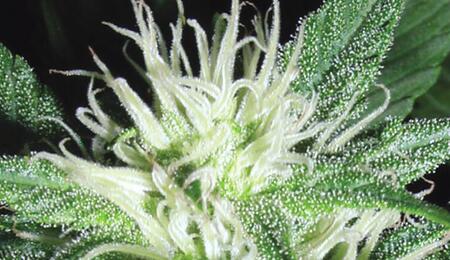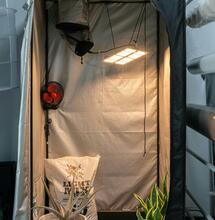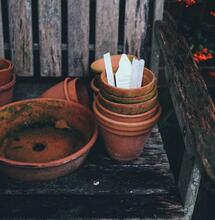Making Seeds at Home - Part One
27 Jul 2018

Making seeds at home requires a secure garden area that can be dedicated to breeding. It must be clean and free of male pollen. Indoor garden rooms and greenhouses are best suited to breeding cannabis if there is danger of rogue pollen from neighboring male cannabis plants contaminating faraway seed crops. If growing more than 1 male to produce pollen, measures must be taken to isolate each male once they start producing pollen. Segregate pollen-producing male plants by keeping them in an enclosed area as far away from flowering females as possible.
 This beautiful medical ‘Chronic’ female is an excellent candidate for a breeding program.[/caption]
Slow and steady breeding is not dynamic, but it is very effective. Pollinate a few branches on several plants and have more seeds than you can grow. The breeding project is never finished.
Grow small seed crops inside a garden closet or inside a portable wardrobe made from fine cloth or something similar that will block pollen from entering or escaping.
Recordkeeping is the most important aspect of cannabis plant breeding. Accurate written and photographic
records with dates help you to make informed decisions.
This beautiful medical ‘Chronic’ female is an excellent candidate for a breeding program.[/caption]
Slow and steady breeding is not dynamic, but it is very effective. Pollinate a few branches on several plants and have more seeds than you can grow. The breeding project is never finished.
Grow small seed crops inside a garden closet or inside a portable wardrobe made from fine cloth or something similar that will block pollen from entering or escaping.
Recordkeeping is the most important aspect of cannabis plant breeding. Accurate written and photographic
records with dates help you to make informed decisions.
 ‘Hash Plant’ × ‘G13’ × ‘Chronic’ yielded this pistil-heavy female. Although showy, the breeder culled the plant in favor of others with heavier bud development.[/caption]
‘Hash Plant’ × ‘G13’ × ‘Chronic’ yielded this pistil-heavy female. Although showy, the breeder culled the plant in favor of others with heavier bud development.[/caption]
 Testing male plants with thin-layer chromatography is a good way to learn much about the cannabinoid profile. Without the test, cannabinoid profile would have to be measured subjectively.[/caption]
Take a thin-layer chromatography test to help make correct choices based upon cannabinoid profiles. Cannabinoid profiles are similar throughout different life stages of a plant, and breeding decisions can be based upon these profiles.
Observe plants carefully as they develop during the season. Watch for desirable characteristics. Pay close attention to flower buds and how they fill out and mature. Apart from looking at resin gland development and stigma senescence, take a toke. Vaporize a sample bud from each plant to determine taste, fragrance, effect, and so on. Remember that flower bud flavors and aromas can change over time as they dry and cure. Additional tasting may be necessary.
Testing male plants with thin-layer chromatography is a good way to learn much about the cannabinoid profile. Without the test, cannabinoid profile would have to be measured subjectively.[/caption]
Take a thin-layer chromatography test to help make correct choices based upon cannabinoid profiles. Cannabinoid profiles are similar throughout different life stages of a plant, and breeding decisions can be based upon these profiles.
Observe plants carefully as they develop during the season. Watch for desirable characteristics. Pay close attention to flower buds and how they fill out and mature. Apart from looking at resin gland development and stigma senescence, take a toke. Vaporize a sample bud from each plant to determine taste, fragrance, effect, and so on. Remember that flower bud flavors and aromas can change over time as they dry and cure. Additional tasting may be necessary.
 Waiting for a male plant to mature is difficult when growing females in the same vicinity.[/caption]
Waiting for a male plant to mature is difficult when growing females in the same vicinity.[/caption]
The basics of breeding cannabis at home are simple:
1. Start with diverse group of plants and know their traits. 2. Cross desirable plants. 3. Select desirable individuals and maintain diversity. [caption id="attachment_8449" align="alignnone" width="500"] This beautiful medical ‘Chronic’ female is an excellent candidate for a breeding program.[/caption]
Slow and steady breeding is not dynamic, but it is very effective. Pollinate a few branches on several plants and have more seeds than you can grow. The breeding project is never finished.
Grow small seed crops inside a garden closet or inside a portable wardrobe made from fine cloth or something similar that will block pollen from entering or escaping.
Recordkeeping is the most important aspect of cannabis plant breeding. Accurate written and photographic
records with dates help you to make informed decisions.
This beautiful medical ‘Chronic’ female is an excellent candidate for a breeding program.[/caption]
Slow and steady breeding is not dynamic, but it is very effective. Pollinate a few branches on several plants and have more seeds than you can grow. The breeding project is never finished.
Grow small seed crops inside a garden closet or inside a portable wardrobe made from fine cloth or something similar that will block pollen from entering or escaping.
Recordkeeping is the most important aspect of cannabis plant breeding. Accurate written and photographic
records with dates help you to make informed decisions.
Naming Varieties
Many varieties have names known only in the local area where they are cultivated. These varieties often bear the name of the region from which they originated or a person with whom they are associated. Other varieties are named for fragrance, bud size, effect, or appearance. The names are often very descriptive and creative!Making Seeds: Step-by-Step
Step One: What is your goal?
Common goals include making seeds for next year’s crop, reproducing new parents just like the old ones, and adding new traits to existing plants. When setting a goal, work with a single trait at a time so that it is easier to control the selection and outcome. Breeding will bring about dominant and recessive genes. Each has its own qualities. Impeccable recordkeeping and a consistent, stable climate are essential. Write out a breeding plan and plot your findings. [caption id="attachment_8448" align="alignnone" width="500"] ‘Hash Plant’ × ‘G13’ × ‘Chronic’ yielded this pistil-heavy female. Although showy, the breeder culled the plant in favor of others with heavier bud development.[/caption]
‘Hash Plant’ × ‘G13’ × ‘Chronic’ yielded this pistil-heavy female. Although showy, the breeder culled the plant in favor of others with heavier bud development.[/caption]
Step Two: Select parents—(A) female, (B) male—to breed.
Few varieties commercially available to medical cannabis gardeners are true-breeding and stable. Most often seeds have many different genes and are not stable or uniform. True-breeding seed stock ensures F1 hybrid seeds that have hybrid vigor. Stable true-breeding stock is sometimes difficult to find from seed companies, and gardeners often elect to stabilize their own. Simply crossing 1 of the stable true-breeding varieties (see list below) with another stable variety will produce an F1 hybrid.List of relatively stable seeds
‘Afghan#1’ ‘Big Bud’ ‘Blackberry’ ‘Burmese’ ‘Durban Poison’ ‘Hash Plant’ ‘Hindu Kush’ ‘Island Sweet Skunk’ ‘KGB’ ‘Malawi Gold’ ‘Master Kush’ = stabilized hybrid ‘Original Blueberry’ = stabilized hybrid ‘Original Haze’ ‘Power Plant’ ‘Skunk Passion’ ‘Skunk #1’ More stabilized seed stock is updated at www.marijuanagrowing.comStep Two A: Select a female that has been flowering for about 4 weeks and has many white stigmas.
Female plants are easy to select. Medical cannabis gardeners and patients know the growth characteristics of each plant in the garden. The most common desirable characteristics include cannabinoid profile with quality fragrance and flavor, strong growth habit, heavy yield, and resistance to diseases and pests. Outdoor gardeners in climate-sensitive areas look for strong branching, a big root system, and tolerance of drought, heat, and cold. [caption id="attachment_8447" align="alignnone" width="500"] Testing male plants with thin-layer chromatography is a good way to learn much about the cannabinoid profile. Without the test, cannabinoid profile would have to be measured subjectively.[/caption]
Take a thin-layer chromatography test to help make correct choices based upon cannabinoid profiles. Cannabinoid profiles are similar throughout different life stages of a plant, and breeding decisions can be based upon these profiles.
Observe plants carefully as they develop during the season. Watch for desirable characteristics. Pay close attention to flower buds and how they fill out and mature. Apart from looking at resin gland development and stigma senescence, take a toke. Vaporize a sample bud from each plant to determine taste, fragrance, effect, and so on. Remember that flower bud flavors and aromas can change over time as they dry and cure. Additional tasting may be necessary.
Testing male plants with thin-layer chromatography is a good way to learn much about the cannabinoid profile. Without the test, cannabinoid profile would have to be measured subjectively.[/caption]
Take a thin-layer chromatography test to help make correct choices based upon cannabinoid profiles. Cannabinoid profiles are similar throughout different life stages of a plant, and breeding decisions can be based upon these profiles.
Observe plants carefully as they develop during the season. Watch for desirable characteristics. Pay close attention to flower buds and how they fill out and mature. Apart from looking at resin gland development and stigma senescence, take a toke. Vaporize a sample bud from each plant to determine taste, fragrance, effect, and so on. Remember that flower bud flavors and aromas can change over time as they dry and cure. Additional tasting may be necessary.
Step Two B: Select a male with desirable characteristics.
Choosing male plants for breeding is difficult. One basic test is to rub the stem with your finger. If it exudes a pungent, resinous odor, it may be rich in cannabinoids. Look for male plants that are short with dense foliage and that contain other desirable characteristics—cannabinoid profile, strong growth, disease and pest resistance, drought, heat and cold tolerance. To determine cannabinoid profiles, make thin-layer chromatography tests before males flower. Soon laboratory analysis of the cannabinoid profile and genetic marker (alleles) tests will become more common. The most reliable way to select the best male breeding stock is to use the pollen from specific males to pollinate chosen males. The plants are grown to maturity and males are then selected. It takes time to stabilize males, and few seed companies put much time into male plant selection. Once selected, a super male and subsequent male lineage can be kept alive for years. Clone promising male plants and cull the rest to keep stock alive. [caption id="attachment_8446" align="alignnone" width="500"] Waiting for a male plant to mature is difficult when growing females in the same vicinity.[/caption]
Waiting for a male plant to mature is difficult when growing females in the same vicinity.[/caption]



.png)